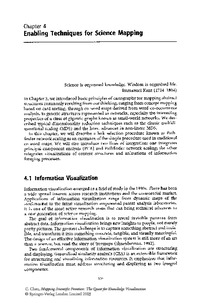Enabling Techniques for Science Mapping |
 |
 Diese Seite wurde seit 2 Jahren inhaltlich nicht mehr aktualisiert.
Unter Umständen ist sie nicht mehr aktuell.
Diese Seite wurde seit 2 Jahren inhaltlich nicht mehr aktualisiert.
Unter Umständen ist sie nicht mehr aktuell.
 Zusammenfassungen
Zusammenfassungen
 In Chapter 3, we introduced basic principles of cartography for mapping abstract structures commonly resulting from our thinking, ranging from concept mapping based on card sorting, through co-word maps derived from word co-occurrence analysis, to generic structures represented as networks, especially the interesting properties of a class of gigantic graphs known as small-world networks. We described typical dimensionality reduction techniques such as the classic multidimensional scaling (MDS) and the latest advances in non-linear MDS.
In Chapter 3, we introduced basic principles of cartography for mapping abstract structures commonly resulting from our thinking, ranging from concept mapping based on card sorting, through co-word maps derived from word co-occurrence analysis, to generic structures represented as networks, especially the interesting properties of a class of gigantic graphs known as small-world networks. We described typical dimensionality reduction techniques such as the classic multidimensional scaling (MDS) and the latest advances in non-linear MDS. Chapter 4 [...] describes three interrelated aspects of science mapping: structural modeling, visual-semantic displays, and behavioraI semantics. StructuraI mapping is concerned with how to extract meaningful relationships from information resources. Visual-semantic displays focus on the design of effective channels for effective communication. Traditionally, structural mapping and visual-semantic display are regarded as the core of information visualization. Behavioral semantics emphasizes the meaning of behavioral pattems in helping us to understand the structure of an information space. It also provides a promising way to build responsive virtual environments. These enabling techniques are expected to play an increasingly important role in mapping scientific frontiers.
Chapter 4 [...] describes three interrelated aspects of science mapping: structural modeling, visual-semantic displays, and behavioraI semantics. StructuraI mapping is concerned with how to extract meaningful relationships from information resources. Visual-semantic displays focus on the design of effective channels for effective communication. Traditionally, structural mapping and visual-semantic display are regarded as the core of information visualization. Behavioral semantics emphasizes the meaning of behavioral pattems in helping us to understand the structure of an information space. It also provides a promising way to build responsive virtual environments. These enabling techniques are expected to play an increasingly important role in mapping scientific frontiers. Dieses Kapitel erwähnt ...
Dieses Kapitel erwähnt ...
 Personen KB IB clear | Vannevar Bush , Chaomei Chen , T. Kohonen , Ben Shneiderman | ||||||||||||||||||||||||||||||||||||||||||||||||||||||
 Begriffe KB IB clear | information retrievalinformation retrieval , information visualizationinformation visualization , MemexMemex , Traveling Salesman ProblemTraveling Salesman Problem | ||||||||||||||||||||||||||||||||||||||||||||||||||||||
 Bücher |
| ||||||||||||||||||||||||||||||||||||||||||||||||||||||
 Texte |
|
 Dieses Kapitel erwähnt vermutlich nicht ...
Dieses Kapitel erwähnt vermutlich nicht ... 
 Nicht erwähnte Begriffe | knowledge visualization |
 Zitationsgraph
Zitationsgraph
 Zitationsgraph (Beta-Test mit vis.js)
Zitationsgraph (Beta-Test mit vis.js)
 Anderswo finden
Anderswo finden
 Volltext dieses Dokuments
Volltext dieses Dokuments
 |  Enabling Techniques for Science Mapping: Artikel als Volltext bei Springerlink ( Enabling Techniques for Science Mapping: Artikel als Volltext bei Springerlink ( : :  , 8260 kByte; , 8260 kByte;  : :  2020-11-28) 2020-11-28) |
 Anderswo suchen
Anderswo suchen 
 Beat und dieses Kapitel
Beat und dieses Kapitel
Beat war Co-Leiter des ICT-Kompetenzzentrums TOP während er Dieses Kapitel ins Biblionetz aufgenommen hat. Die bisher letzte Bearbeitung erfolgte während seiner Zeit am Institut für Medien und Schule. Beat besitzt kein physisches, aber ein digitales Exemplar. Eine digitale Version ist auf dem Internet verfügbar (s.o.). Es gibt bisher nur wenige Objekte im Biblionetz, die dieses Werk zitieren.















 Biblionetz-History
Biblionetz-History